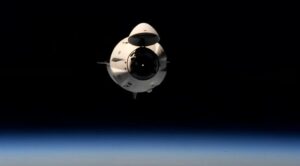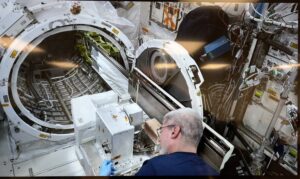Aerial antenna for Venus mission test
Thursday, 03 March 2022 13:15 Image:
Aerial antenna for Venus mission test
Image:
Aerial antenna for Venus mission test Roscosmos head again questions future of ISS while NASA emphasizes cooperation
Thursday, 03 March 2022 11:45
The head of Roscosmos has renewed threats to terminate Russian participation in the International Space Station even as NASA says operations on the station remain normal.
The post Roscosmos head again questions future of ISS while NASA emphasizes cooperation appeared first on SpaceNews.
“Nothing to share”: South Korean firm turns down Ukrainian request for satellite imagery
Thursday, 03 March 2022 10:28
South Korea’s Earth observation company SI Imaging Services (SIIS) turned down a request to share satellite imagery of Ukraine and neighboring countries to assist Ukrainian efforts to repel Russia’s invasion.
NASA awards SpaceX three additional commercial crew missions
Thursday, 03 March 2022 09:34
NASA ordered three more commercial crew missions to the International Space Station from SpaceX Feb. 28 at a price of more than three-quarters of a billion dollars.
The post NASA awards SpaceX three additional commercial crew missions appeared first on SpaceNews.
Russian move to hold up OneWeb launch may affect entire space industry
Thursday, 03 March 2022 05:27 Russia's invasion of Ukraine hit the space industry harder Wednesday after Russian space agency Roscosmos said it would hold up a satellite launch for a British company - which experts say may completely shift the industry away from Russia.
OneWeb, a communications satellite company partly owned by the British government, intended to launch 36 satellites Friday on a Russian Soyuz rocket. B
Russia's invasion of Ukraine hit the space industry harder Wednesday after Russian space agency Roscosmos said it would hold up a satellite launch for a British company - which experts say may completely shift the industry away from Russia.
OneWeb, a communications satellite company partly owned by the British government, intended to launch 36 satellites Friday on a Russian Soyuz rocket. B Fleet Space Technologies wins Australian Government grant to build space manufacturing hub
Thursday, 03 March 2022 05:27 Fleet Space Technologies is delighted to announce that the Australian Government has committed $20million (USD) to the development of the Space Manufacturing Hub in Adelaide, South Australia. This adds to funds already committed by The Government of South Australia ($20million AUS) and a consortium of leading space, aerospace and advanced air mobility companies including Fleet, Q-CTRL, AtSpace P
Fleet Space Technologies is delighted to announce that the Australian Government has committed $20million (USD) to the development of the Space Manufacturing Hub in Adelaide, South Australia. This adds to funds already committed by The Government of South Australia ($20million AUS) and a consortium of leading space, aerospace and advanced air mobility companies including Fleet, Q-CTRL, AtSpace P Airbus Ventures invests in CesiumAstro's Series B
Thursday, 03 March 2022 05:27 Airbus Ventures proudly announces its investment in CesiumAstro Inc., a developer of advanced aerospace communication systems, which today publicized its $60 million oversubscribed Series B funding round, co-led by Airbus Ventures and Forever Ventures, with strategic participation from L3Harris Technologies (NYSE: LHX). Returning investors include Kleiner Perkins, Lavrock Ventures, Franklin Temp
Airbus Ventures proudly announces its investment in CesiumAstro Inc., a developer of advanced aerospace communication systems, which today publicized its $60 million oversubscribed Series B funding round, co-led by Airbus Ventures and Forever Ventures, with strategic participation from L3Harris Technologies (NYSE: LHX). Returning investors include Kleiner Perkins, Lavrock Ventures, Franklin Temp First Platforms are Retracted Ahead of Artemis I First Rollout to Launch Pad
Thursday, 03 March 2022 05:27 The Artemis I Moon rocket is getting closer to rolling out of the Vehicle Assembly Building (VAB) at NASA's Kennedy Space Center in Florida for the first time.
The first two of 20 platforms surrounding the Space Launch System (SLS) and Orion spacecraft that allow work on the integrated system inside the building were retracted for roll out to Launch Complex 39B. Teams retracted the platfor
The Artemis I Moon rocket is getting closer to rolling out of the Vehicle Assembly Building (VAB) at NASA's Kennedy Space Center in Florida for the first time.
The first two of 20 platforms surrounding the Space Launch System (SLS) and Orion spacecraft that allow work on the integrated system inside the building were retracted for roll out to Launch Complex 39B. Teams retracted the platfor Lockheed Martin selects mission payload providers for missile warning satellite system
Thursday, 03 March 2022 05:27 Lockheed Martin has selected Raytheon Technologies to provide a second mission payload for the Next Generation Overhead Persistent Infrared Geosynchronous Earth Orbit Block 0 missile warning satellite system - also known as NGG. Both Raytheon Technologies and Northrop Grumman are each already on contract to provide one mission payload for the three-satellite procurement.
Lockheed Martin is
Lockheed Martin has selected Raytheon Technologies to provide a second mission payload for the Next Generation Overhead Persistent Infrared Geosynchronous Earth Orbit Block 0 missile warning satellite system - also known as NGG. Both Raytheon Technologies and Northrop Grumman are each already on contract to provide one mission payload for the three-satellite procurement.
Lockheed Martin is Northrop Grumman and Ball Aerospace to develop new missile warning system sensor
Thursday, 03 March 2022 05:27 Northrop Grumman and Ball Aerospace will design and develop the two mission payloads for the U.S. Space Force's Next Generation Overhead Persistent Infrared Polar (NGP) program.
"NGP combines Northrop Grumman's proven experience in missile warning and defense with Ball Aerospace's expertise in optical sensors and mission data processing," said Sarah Willoughby, vice president, overhead per
Northrop Grumman and Ball Aerospace will design and develop the two mission payloads for the U.S. Space Force's Next Generation Overhead Persistent Infrared Polar (NGP) program.
"NGP combines Northrop Grumman's proven experience in missile warning and defense with Ball Aerospace's expertise in optical sensors and mission data processing," said Sarah Willoughby, vice president, overhead per Using artificial intelligence to find anomalies hiding in massive datasets
Thursday, 03 March 2022 05:27 Identifying a malfunction in the nation's power grid can be like trying to find a needle in an enormous haystack. Hundreds of thousands of interrelated sensors spread across the U.S. capture data on electric current, voltage, and other critical information in real time, often taking multiple recordings per second.
Researchers at the MIT-IBM Watson AI Lab have devised a computationally effi
Identifying a malfunction in the nation's power grid can be like trying to find a needle in an enormous haystack. Hundreds of thousands of interrelated sensors spread across the U.S. capture data on electric current, voltage, and other critical information in real time, often taking multiple recordings per second.
Researchers at the MIT-IBM Watson AI Lab have devised a computationally effi How scientists designed the aerodynamic configuration of Mars ascent vehicles?
Thursday, 03 March 2022 05:27 According to the white paper, China's Space Activities in 2016, the Mars sample return mission represents one of the main tasks to be implemented in China's deep space exploration field in the next 10 years. As the key technologies to be developed for Mars sample return, the design, analysis, and verification for Mars take-off and ascent can play a very important support role in the engineering
According to the white paper, China's Space Activities in 2016, the Mars sample return mission represents one of the main tasks to be implemented in China's deep space exploration field in the next 10 years. As the key technologies to be developed for Mars sample return, the design, analysis, and verification for Mars take-off and ascent can play a very important support role in the engineering OneWeb leaves Baikonur Cosmodrome after Roscosmos ultimatum
Wednesday, 02 March 2022 22:23
OneWeb ordered staff to leave Russia's Baikonur Cosmodrome in Kazakhstan on Wednesday amid an impasse over the launch of its latest batch of satellites on a Soyuz rocket, an executive for the U.K.-based company said.
Satellite images show Russia’s troop movements but can they reveal intent?
Wednesday, 02 March 2022 21:23
Commercial spy satellites provides extraordinary intelligence about Russian troop advances in Ukraine and attacks on Ukrainian cities. But as the conflict grinds on, intelligence analysts at times are still being challenged to figure out Russian intent.
Skycorp to test “USB for space” cable outside ISS
Wednesday, 02 March 2022 21:11
Skycorp Inc., a California company focused on orbital logistics, is preparing to test a key component of future satellite servicing vehicles on the International Space Station.
The post Skycorp to test “USB for space” cable outside ISS appeared first on SpaceNews.

